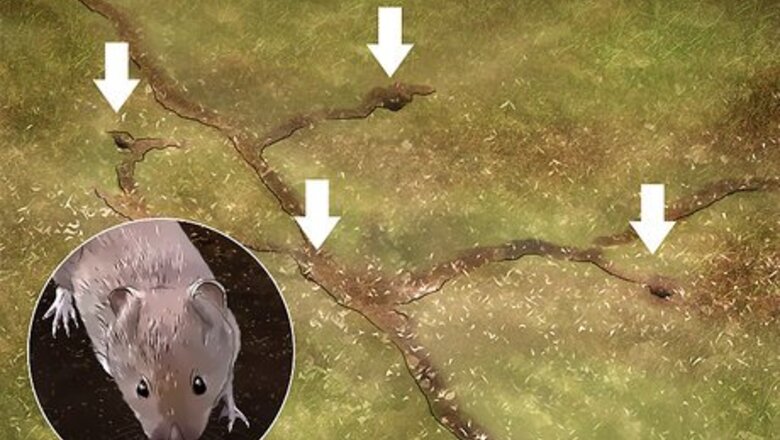
views
Setting Traps
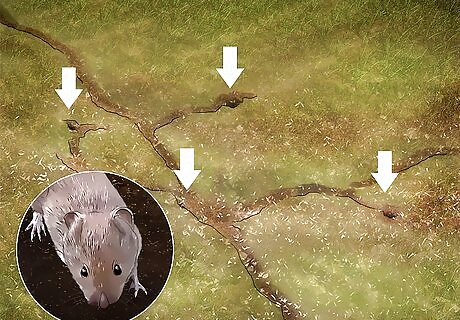
Set traps for a small, concentrated infestation. Before setting lethal traps, make sure it's legal to exterminate or relocate voles in your area. Traps can be an effective way to control vole populations that are concentrated in a small area, like an average residential yard. However, they're not a practical management option for infestations that affect larger areas, such as an orchard. Signs of a vole problem include damage to crops and garden plants, holes and unsightly areas in lawns, and gnaw marks on tree bark near ground level. For widespread damage over an extensive area, rodenticide bait will probably be more effective than snap or box traps.

Place snap-type traps at a tunnel entrances. Bait snap-type mouse traps with apple slices or peanut butter mixed with oatmeal. Set them perpendicular, or at a right angle, to the tunnel entrances; use 1 trap per 100 sq ft (9.3 m) of land. Check your traps daily, and remove any dead and captured voles. Purchase covered traps, or fold a shingle over a standard trap to avoid catching birds and other non-target animals. Wear gloves when you dispose of any trapped voles. Bury them or dispose of them in a tightly sealed bag. Don't leave dead voles in the traps, as this would promote disease and attract other pests. Be sure to keep children and any pets away from snap traps.
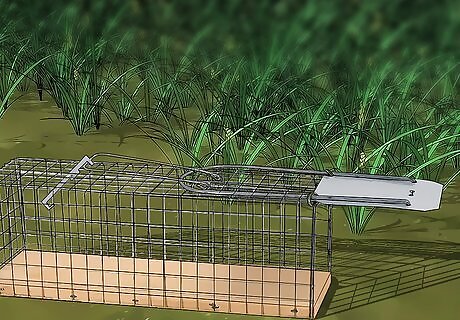
Use box traps if you want a non-lethal option. If it's illegal to kill voles in your location, or if you'd prefer a non-lethal option, purchase mouse-sized box traps. Bait the traps and place them by tunnel entrances. Check the traps in the morning and evening, and relocate any caught voles at least ⁄2 mi (0.80 km) away from any residential or commercial property. Make sure it's legal in your area to catch and release voles and other small animals.
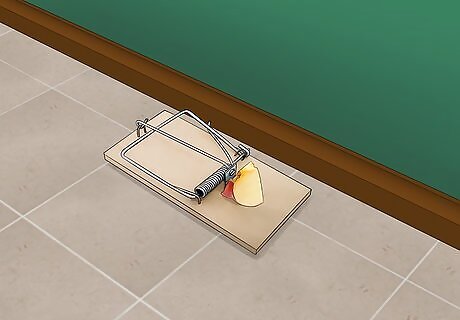
Control voles in your home with traps, if necessary. Voles rarely stray from their burrows, so home infestations are rare. However, if you suspect there's a vole problem in your home, garage, or shed, manage them with traps. Set snap or box traps in any areas where you've found damage, droppings, or evidence of burrowing. Dispose of any caught voles as soon as possible. Wear gloves when you handle live or dead voles. Be sure to keep small children and pets from the traps. Use live traps if killing voles is illegal in your area.
Using Rodenticide
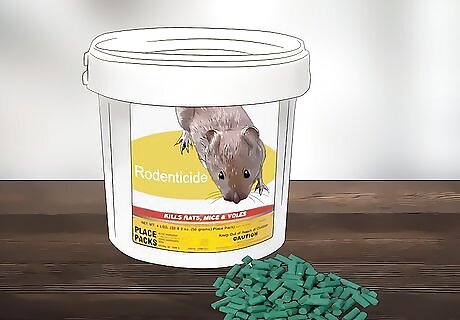
Use a rodenticide in combination with other methods. Chemical control is most effective in combination with preventative methods, such as installing barriers and removing food sources. Find an anticoagulant rodenticide labeled for voles at garden centers or retail stores. Read your product's instructions, use it as directed, and take all recommended safety precautions. For general guidelines, set 2 tablespoons (29.6 ml) of rodenticide pellets in a bait container at the opening of a vole tunnel. Keep small children and pets away from rodenticide. Before you put out rodenticide bait, make sure it's legal to use chemicals to control voles in your area.

Create rodenticide bait stations to protect non-target animals. To avoid killing birds and other non-pest animals, use store-bought covered bait containers. Alternatively, you could make your own using PVC pipe or water-repellent mailing tube. Cut a 12 in (30 cm) length of pipe or tube, place the rodenticide bait inside, and bury it inside a vole tunnel. Accidentally killing non-target species may be illegal in your area, so taking safety precautions is important.
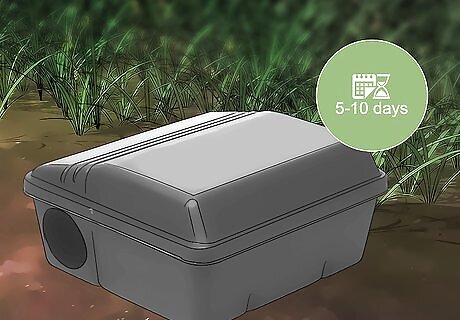
Continue baiting the tunnels for 5 to 10 days. Anticoagulant rodenticide needs to be consumed for 5 days in order to be effective. Check your bait stations every other day and, if necessary, refill them. Monitor them for up to 10 days, then place traps baited with apple or peanut butter by tunnel entrances to check your progress. If you don't catch any voles, your chemical applications were effective. If you still have a vole problem, continue using rodenticide bait, or consider calling a professional. Remember to promptly dispose of any dead voles.
Deterring Voles in Your Lawn and Garden
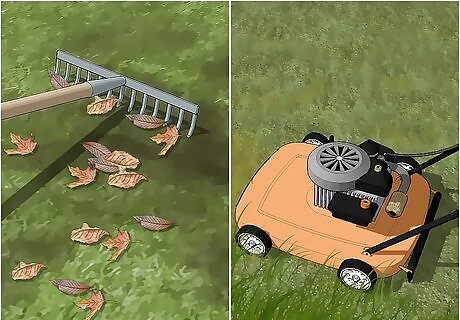
Keep your yard tidy and grass trimmed short. Voles love creating their runways in underbrush and overgrown grassy areas. Look around your yard for any areas that might provide shelter, and eliminate them. Get rid of tall weeds and grass that provide cover, and be sure to dispose of grass and leaves after you mow or weed your yard. Additionally, voles like densely mulched areas, so avoid mulching garden areas and around the bases of trees if you have a vole problem.
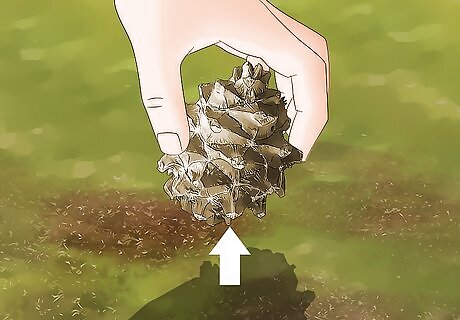
Remove fallen fruit, pine needles, and other debris. Voles eat grasses, nuts, roots, fruits, vegetables, bark, and tree needles. Other debris, such as branches, lawn clipping, and leaf piles, can offer cover. Promptly get rid of any fallen fruit or vegetation that might provide sources of food or protection. Eliminating food sources and debris will discourage voles from infesting your yard.
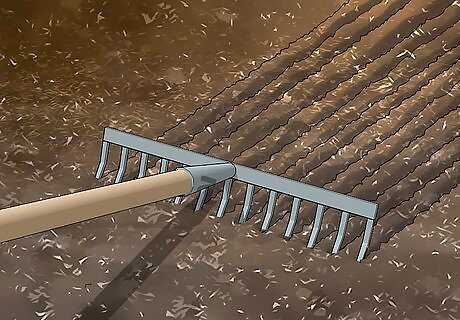
Cultivate the soil in your yard or garden. When you no longer catch voles in your traps, destroy the tunnel entrances and runway systems with a shovel. At least once a year, use shovels and spades to turn over your soil. Regularly cultivating your soil repairs damage to your yard and can deter future infestations. Cultivate dense clay soils in autumn, and sandier soils in spring. Divide your yard into strips, till trenches along each strip, then fill trenches with the soil from the strip beside it. Additionally, it's wise to test your soil and, if necessary, add fertilizer or adjust the pH when you till.
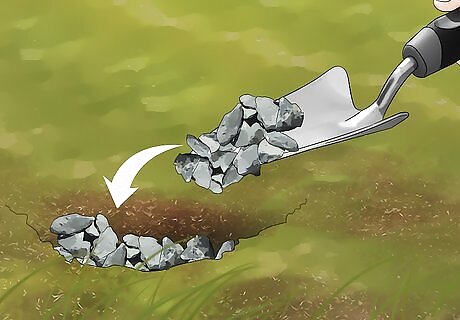
Dig sharp materials around their tunnels. Try adding coarse gravel or sand to vole tunnels and around plants that might provide food sources. Spread the sharp material around the bed or tunnel entrance, then use a shovel or spade to mix it into the soil. Sharp gravel or sand can make it difficult for voles to move around and dig.
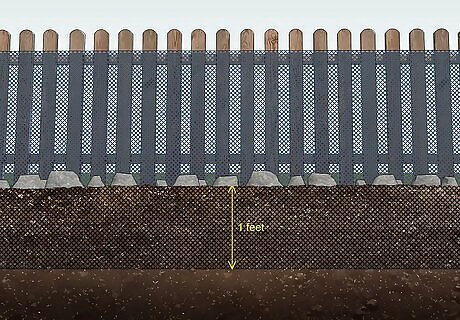
Add a mesh barrier to trees, gardens, and fence lines. Clear weeds and brush before installing mesh barriers. Use stakes to support cylinders of ⁄4 in (0.64 cm) wire screen mesh or hardware cloth around your trees and garden beds. The mesh shouldn't hug or press into your tree trunks or other plants. Bury a barrier 12 in (30 cm) into the ground. Above ground, your barrier should reach a height of about 18 in (46 cm). For colder climates, make sure the barrier is as tall as your highest snowfall. Additionally, you can attach screen mesh to the bases of fences along your property line. Be sure to bury the mesh to prevent voles from burrowing under the barrier. Find wire mesh or hardware cloth online or at your local hardware store.




















Comments
0 comment